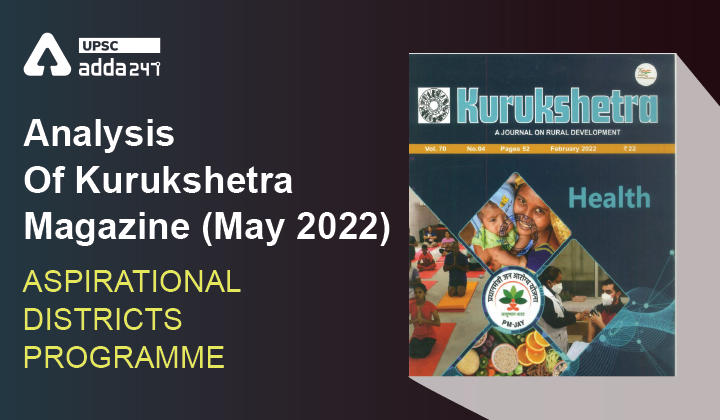Table of Contents
Introduction
- Launched by the Hon’ble PM in January 2018, the Aspirational Districts programme aims to quickly and effectively transform 117 most under-developed districts across the country.
- NITI Aayog has identified 117 districts as Aspirational Districts based on their performance in 49 Key Performance Indicators across five themes namely health and nutrition, education, agriculture and water resources, financial inclusion and skill development and basic infrastructure.
- ADP is based on 3Cs – the ‘Convergence, Competition and Collaboration’ approach.
Key Points
- The broad contours of the programme are Convergence (of Central & State Schemes), Collaboration (of Central, State level ‘Prabhari’ Officers & District Collectors), and Competition among districts through monthly delta ranking; all driven by a mass movement.
- With States as the main drivers, this program focuses on the strength of each district, identifying low-hanging fruits for immediate improvement and measuring progress by ranking districts on a monthly basis.
- The ranking is based on the incremental progress made across 49 Key Performance Indicators (KPIs) under 5 broad socio-economic themes – Health & Nutrition, Education, Agriculture & Water Resources, Financial Inclusion & Skill Development and Infrastructure.
- The delta-ranking of Aspirational Districts and the performance of all districts is available on the Champions of Change Dashboard.
- Another focus of the programme is to further dive into the progress at the block level within each district. The districts are encouraged to monitor the progress of the blocks that lead to the overall improvement of the district.
- The Aspirational Districts Programme essentially is aimed at localizing Sustainable Development Goals, leading to the progress of the nation.
Institutional arrangement for the programme
- At Government of India level, programme is anchored in NITI Aayog. In addition, individual Ministries have been given responsibility to drive progress of districts.
- For each district, a central Prabhari officer of the rank of Additional Secretary/Joint Secretary has been nominated.
- States have been requested to form a committee under Chief Secretary to implement the programme. States have also nominated nodal officers and also State level Prabhari officer.
Core Strategy of ADP
- The core strategy in the program may be summarised as:
- States as main drivers
- Work on the strength of each district.
- Make development as a mass movement in these districts.
- Identify low hanging fruits by identifying the strength of the districts so that this can work as a catalyst for development.
- Measure progress and rank districts to spur a sense of competition.
- Districts to aspire: from becoming States’ best to Nation’s best.
Areas of Focus
This programme is for overall transformation of the district using mass movement approach. Different districts have different strength and weakness and detail of district level plans would vary. At the same time, to keep the approach focussed, the programme seeks to focus in following sectors as these are important for all districts:
- Health and Nutrition
- Education
- Agriculture and Water Resources
- Financial inclusion and skill development
- Basic Infrastructure including access to road, potable water, rural electrification and individual household toilets.
Key achievements
- Aspirational Districts in the country have witnessed significant progress in key development areas in the last four years.
- A comparison between the Aspirational Districts and their counterparts found that ADs have outperformed non-ADs.
- The partnership among district teams and regular outreach programmes have played a key role in this rapid improvement.
- This programme has proved to be a standout example of data-driven governance and the ranking of districts across key social parameters has played a vital role in their transformation.
- Many NGOs, development partners, and members of civil society have collaborated actively, especially during the time of the COVID-19 pandemic to ensure that the outreach objectives of the Aspirational Districts programme continue to reach the last mile.



 TSPSC Group 1 Question Paper 2024, Downl...
TSPSC Group 1 Question Paper 2024, Downl...
 TSPSC Group 1 Answer key 2024 Out, Downl...
TSPSC Group 1 Answer key 2024 Out, Downl...
 UPSC Prelims 2024 Question Paper, Downlo...
UPSC Prelims 2024 Question Paper, Downlo...




